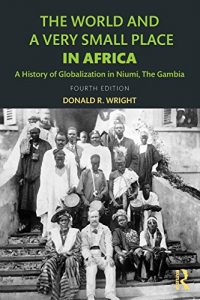The World and a Very Small Place in Africa: A History of Globalization in Niumi, The Gambia, 4th edition
The World and a Very Small Place in Africa: A History of Globalization in Niumi, The Gambia, 4th edition Reviewed by: Dr. Paul Chiudza Banda, Assistant Professor of History, Tarleton State University. This publication is in its fourth edition. Its purported primary setting is an area called Niumi, located on the Atlantic coast, in The Gambia. The author adopted the globalization approach to narrate the historical trajectories that Niumi has undergone over the last six hundred years. Niumi covers an area of less than 400 square miles (pp.2-3). The author relied on various primary and secondary sources. These ranged from personal observations, oral interviews, archival documents, and other published ones (pp.3-5). Professor Wright uses the case of Niumi’s long history, and that of The Gambia, by linking it with other global historical developments. He defines globalization as a process of the integration of the world’s people, of their increasing interaction, and of the developing closer economic, social, and cultural relationships (p.7). The author agrees with and borrows from the works of reputable scholars, including Immanuel Wellerstein, A.G. Hopkins, and the father and son duo of McNeill and McNeill. Wellerstein is noted for his “world systems theory”; A.G. Hopkins, Globalization in World History (2002); and McNeill and McNeill, The Human Web (2003). From Hopkins, the author adopted the demarcated four main phases of the globalization process. The four phases are as follows: Archaic globalization (before 1600 CE); Proto-globalization (between 1600 and 1800 CE); Modern globalization (from 1800 CE to the mid-20th century); and Post-colonial globalization (from the 1950s to the present). From the McNeills, he adopted the “webs of interaction approach,” to describe the various types of connections across the globe (pp.7-9). In Part I, the author focuses on the initial phases of interaction between the people of Niumi and Portuguese adventurers starting in 1446 CE. In that year, the adventurer Nuno Tristao reached The Gambia region. He and his fellow sailors were met with hostility by the people of Niumi and their leader, titled Mansa. A decade later, another Portuguese adventurer, Diogo Gomes, was well-received by the Mansa, beginning a long historical process of Niumi’s global interactions (pp.13-19). These processes were also extensions of Western European global expansion dating back to the 9th century CE (pp.20-21). It encountered West Africa, which was a hub of Trans-Saharan trade and the spread of Islam (pp.25-28). Niumi initially supplied salt from the Atlantic Ocean, in exchange for such items as cloth, iron, and gold (pp.33-75). Part II focuses on the proto-globalization phase, characterized by increasing global interaction. For Niumi, this came alongside political and economic changes related to the growth of the Atlantic economy. While few of her people were sold into slavery, Niumi experienced three major changes, ranging from ecological, economic, and religious. Ecologically, the limited amounts of rainfall led to reduced food production; economically, there were increased trade transactions in the Atlantic world; and religiously, there was an increased spread of Islam. The Mansa also amassed more power and wealth from the proceeds of trade (pp.79-100). For the modern globalization phase, in Part III, the focus is on the period from 1815 onwards. Launched by the reign of Kolimanka Manneh (1815-1823), he increased trade transactions with the Atlantic world. Following the abolition of the slave trade, Niumi shifted to “legitimate trade,” of hides, ivory, beeswax, peanuts, and gold. The proceeds were used to purchase European manufactured goods, especially textiles, household utensils, and weapons (pp.124-131). By the end of the 19th century, The Gambia fell under British colonial rule, leading to Niumi’s connection to wider global developments. Mansa Sonko signed several treaties that brought his state under British rule, pledging loyalty to the British Crown, in return for annual payments of about £100. The Gambia was affected and participated in such global processes as the two World Wars, the Great Depression, and post-war colonial development planning, until her independence in February 1965 (pp.149-155). The last part, Part IV, covers the mid-1950s to the present, characterized by three major forces, namely technological advances, increased globalization, and climate change. Then there was the rise of the Cold War; the influence of the Bretton Woods institutions, and the global economic crisis of the late 1970s and the 1980s. This saw the introduction of Structural Adjustment Programs (SAPs), which for The Gambia bore very little fruits. Poverty levels remain high, life expectancy is as low as 42 years, and under 5 mortality rates pegged at 241 per thousand (pp.197-216). The authoritarian rule of Yahya Jammeh, a former military officer, from 1994-2017, did not help matters. Initially shunned by the West until he “relaxed” his grip on power, Jammeh oppressed Gambians and subjected them to rigged elections (pp.220-227). The country, and Niumi included, have thus not benefited from the globalization process, with limited access to education, health, and transport and communication opportunities (pp.231-272). This is generally a must-read book, with significant contributions to global and African history. Its transnational and multi-thematic nature means it can be read by people with a wide range of academic interests. On the other hand, the notable shortfall is that to a large extent, the analysis of the globalization process has been top-down, rather than one that adopts a bottom-up approach, with the people of Niumi being dominant. That shortfall aside, I recommend this book to those interested in world/global history, African history, and the state in post-colonial Africa. This will be captivating to read. |



